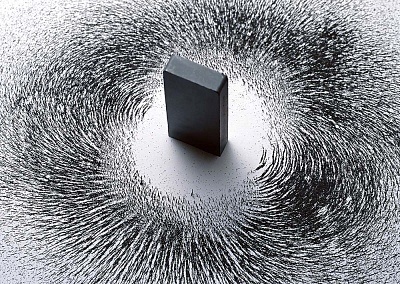Magnets are used in many different applications given their inherent strength in relation to mass and weight. Electromagnets, because they can be turned off and on, are used in powerful pieces of equipment and vehicles, such as magnetic-levitation, or maglev, trains. However, permanent magnets are also very versatile and strong components of myriad applications as well.
What is a Permanent Magnet and How Does it Work?
- Hard magnetic ferrites are used as permanent magnets and in refrigerator seal gaskets. They also are used in microphones and speaker gaskets. The largest market for permanent magnets is in small motors for cordless appliances and in automobile applications.
- Permanent magnets are limited by the structure of the material. And the strongest magnetic field of a permanent magnet is about 8,000 gauss. The strongest magnets here at the Magnet Lab are 450,000 gauss, which would be almost 50 times stronger than that. There are two main different types of magnet, permanent magnets.
- However, permanent magnets are also very versatile and strong components of myriad applications as well. What is a Permanent Magnet and How Does it Work? A magnet is any material or substance that projects a magnetic field. A magnetic field is a type of vector field that aligns electric charges on a dipolar outlay.
- All the possible ways to make a permanent magnet are listed in Joseph Henry's student notebook, which is kept at Princeton University. Henry, the 18th century American physicist, is known – together with Michael Faraday – as the father of electrical technology, so it's no surprise that one of the methods he describes uses electricity.
Permanent magnets are also used as timing motors in industrial robots, military and space technology, and clocks and watches. Among the commercially important families of permanent magnets, two contain rare earth elements, namely, the samarium–cobalt and neodymium–iron–boron.

A magnet is any material or substance that projects a magnetic field. A magnetic field is a type of vector field that aligns electric charges on a dipolar outlay. Magnets have both a north and south pole, which align to the earth’s magnetic northern and southern poles (and which are not fixed points on the map, but rather varying areas generally located in the regions of the geographic north and south poles). Like poles repel from one another, while unlike poles attract. Ferromagnetic materials, meaning materials which contain some degree of iron, can usually be permanently magnetized, with a catch: if magnets are heated to excessive, known temperatures, they can lose their magnetism. This can be remedied by remagnetising through a process of slowly cooling the magnet.
Types of Permanent Magnet Applications
Scientists use four basic ways to categorize magnets, based on how their magnetic force is used. We list the categories below along with permanent magnet examples.
Category 1: The magnet’s attraction or repelling force. These applications are the simplest use of magnets. A simple refrigerator magnet is a perfect example—a picture or slogan on a small piece of laminated cardboard with a small bar magnet glued to the back which attracts to a metal refrigerator door.
Category 2: The magnet’s ability to convert electric force into mechanical force.
Electric motors are good examples of using magnets to convert electric energy into mechanical force. While electromagnets are more commonly used for electric motors, permanent magnets can be used as well. A magnet is placed in a conductive substance, and then the magnetic field yielded by the magnet turns another piece of equipment, which rotates the motor rapidly.
Category 3: The magnet’s ability to convert mechanical force into electric force.
Generators predominately use this ability. In contemporary times, electromagnets are more often used for power generating turbines, but permanent magnets still play a part. Very simply, two permanent magnets are placed opposite one another, with like sides facing. Their repelling forces rotate a turbine, which then turns a piece of equipment known as an armature. This churning armature generates electricity, which can then be transferred to other purposes.
Category 4: The magnet’s ability to affect ion beams.
Cathode-ray tubes, a type of vacuum tube for focusing electrons, use permanent magnets for aiming purposes. A ring of permanent magnets, alternating north and south poles, is on the end of an electron gun’s yoke, and these ringed magnets can be rotated to focus the beam for better reception or tighter focus.
Other Magnets Articles
More from Electrical & Power Generation
Related Resources
And the Award Goes to..
Kroger Launches Americas' First Grocery Customer Fulfillment Center
U.S. Adds New Vaccine Tax Credit for Small, Medium Businesses
United Airlines, Nike, Siemens, 9 Other Businesses Partner to Pursue Trash-derived Airline Fuel
The Secrets to Setting Your Family Business Up for Success
Browse by Category

A permanent magnet stepper motor is a compatible and highly efficient device that has numerous applications. Since the rotor is made of permanent magnets, it does not need any external excitation which makes it very useful in applications such as toys, small motors, etc. Because of its design aspects, the step-angle of each rotation can be easily designed, which makes it useful in delicate applications such as medical instruments and aeronautical structures. Due to its small size, it is highly mobile and easy to use. This article discusses an overview of the permanent magnet stepper motor.
What is a Permanent Magnet Stepper Motor?
Definition: It’s an electromechanical energy conversion device, which converts electrical energy to mechanical energy. In a stepper motor, both the rotor and stator magnetic fields are excited such that interaction of the rotor magnetic field and stator magnetic field produces torque. In a permanent magnet stepper motor, the rotor coils are not excited, instead, we use permanent magnets.
In conventional stepper motors, electromagnets are used, which needs to be externally excited for the creation of a rotor magnetic field. But in this case, we use permanents magnets. This reduces the rotor excitation system and makes the motor more compatible for operation. Due to the absence of rotor excitation, the losses are also reduced.
Permanent Magnet Stepper Motor Construction
It consists of two fundamental parts. The stationary part also called the stator. In stator, stator poles are placed such that, when excited with windings as shown in the diagram, each stator pole forms one magnetic pole. If it is a two-pole machine, then the opposite poles are excited with common winding connected in series, such that, each of the opposite poles from North and South.
Similarly, the other two pairs of poles are excited with series winding in one cycle, such that they too form a pair of poles. The rotor is made of permanent magnets. There are many materials like ceramic which can be used as permanent magnets. The rotor magnets are connected to an external shaft, such that, on rotation, it provides the mechanical output.
Principle of Stepper Motor
The working principle of the stepper motor is similar to that of a conventional motor. It works on the principle of Lorentz Force law. According to which, whenever a current-carrying conductor is placed in a magnetic field, it experiences a force, due to the interaction of fluxes.
The flux which interacts is stator magnetic flux and rotor magnetic flux. The stator magnetic flux is created due to external excitations and the rotor magnetic flux is created due to permanent magnets. It is also to be noted that, the direction of the motor is governed due to Fleming’s left-hand rule.
Working of Permanent Magnet Stepper Motor
Permanent Magnet 640
The working permanent magnet stepper motor can be explained in the following modes
Mode 1– In this mode, the A phase of the stator poles are excited together with series winding to create two pairs of magnetic poles. It may be noted that, in this mode, the B phase is not excited at all. When the A phase is excited, it forms the North and South pole. At this moment, the rotor magnetic poles are attracted to the stator magnetic poles.

Mode 2 – In this mode, the B phase of the stator poles are excited together with series winding to create two pairs of magnetic poles. It may be noted that, in this mode, the A phase is not excited at all. When the B phase is excited, it forms the North and South pole. At this moment, the rotor magnetic poles are attracted to the stator magnetic poles. Which makes the rotor rotate in the clockwise direction from Mode 1.
Buy Permanent Magnets
Mode 3 – Again In this mode, the A phase of the stator poles are excited together with series winding to create two pairs of magnetic poles. It may be noted that, in this mode, the B phase is not excited at all. When the A phase is excited, it forms the North and South pole. At this moment, the rotor magnetic poles are attracted to the stator magnetic poles. It makes the rotor rotate in the clockwise direction from mode 2.
Mode 4– Again In this mode, the B phase of the stator poles are excited together with series winding to create two pairs of magnetic poles. It may be noted that, in this mode, the A phase is not excited at all. When the B phase is excited, it forms the North and South pole. At this moment, the rotor magnetic poles are attracted to the stator magnetic poles. Apps for mac games free. Which makes the rotor rotate in the clockwise direction from Mode 3.
In this manner, the rotor makes one complete revolution from mode 1 to mode 4.
Advantages and Disadvantages of Stepper Motor
The advantages of a permanent magnet stepper motor are
- It is compact and small in size, which makes it useful in many applications
- Due to the absence of any external excitation, the losses are less
- Due to the absence of any external excitation, the maintenance is less.
- It can be connected to the external circuit, to control the speed of the motor
- Sensors may be used to locate the rotor windings
- Can be operated in a wide range of speed and torque.
- Precise Control
The disadvantages of a permanent magnet stepper motor are
- Due to limitations in permanent magnet, it cannot be used for high power applications
- Torque produced is limited
- The life of a permanent magnet is limited.
Permanent Magnet Synchronous Motor

Permanent Magnet Examples
Applications
The applications of a permanent magnet stepper motor are
Permanent Magnet Dc
- Aeronautical industry
- Robotics
- Toys
- Manufacturing
- Control industry
- Mills and printing
What Objects Use Permanent Magnets
Hence we have seen the working principle, constructional aspects, and applications of the permanent magnet stepper motor. It must be noted which magnetic materials are used to improve the performance of these motors and how to control the step angle of the machine?
